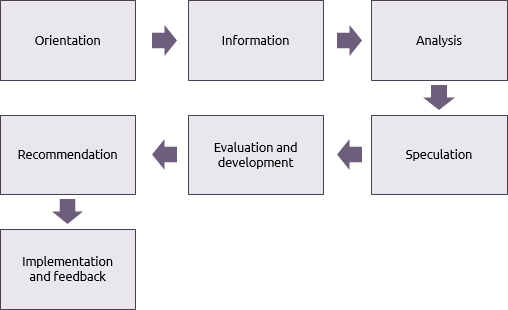Value management is concerned with maximising the value of benefits delivered by a project or programme. Since ‘value’ is a subjective term it is important that a balance is maintained between different stakeholder perceptions of what value actually means.
There are many different approaches to the value management procedure but they all follow the same general principles shown below. This procedure initially spans the requirements management and solutions development functions but some aspects should be continued through the delivery phase of the life cycle.

Orientation
This step in the procedure is sometimes referred to as ‘framing’. It draws up the terms of reference for the value management study and would typically include:
- setting the objectives for a value management study;
- defining the composition of the study team;
- outlining the information on which to base the study;
- consultation with staff;
- detailed planning;
- whether to employ professional assistance.
Information
Sometimes called data gathering, this step is where the information is defined, collected and distributed to the members of the team. Relevant information may include:
- drawings;
- specifications;
- supplier details;
- current manufacturing, development or construction methods;
- user requirements;
- market trends;
- the competition.
The person responsible for the study will need to collect information from a variety of sources. This needs to be done with some care since those sources may have vested interests in the present way of doing things.
Analysis
Many regard this step as being the heart of Value Management. Analysis can take a variety of forms to suit the technical nature of the project. The most common is Function Analysis. The essence of this analysis is to look at the component parts of the project and decide what function(s) they perform. By identifying the function of each component, its contribution towards benefits specified in the business case can be established.
Some projects will contain far too many individual functions for all of them to be fully analysed. Pareto’s principle is well worth applying here. 80% of the costs are likely to be incurred by 20% of the components, so it makes sense to apply the full force of Value Management to that 20%.
Speculation
Alternatively referred to as the creative step, this part of the procedure is where brainstorming is used to explore alternative ways of achieving the same or better functionality, hopefully at lower cost. It may also reveal components, which in the present environment are providing unnecessary functionality.
Evaluation and development
Also called judgement, this step examines the results of the brainstorming in order to filter out the ideas that have the greatest potential.
These ideas are developed into substantial proposals for changes to the technical specification. All implications must be considered i.e. what effect will the proposed changes have in terms of schedule, cost, quality, risk etc.
Recommendation
Sometimes referred to as reporting, this is where the developed ideas are submitted to the stakeholders with a recommendation and justification of any investment required. Proposed changes are selected and approved for implementation.
Implementation and feedback
Finally, the accepted proposals are acted upon by updating specifications and the business case. The principles of value management should be continually applied during the control of the project, and as part of change control in particular, to ensure that the work continues to deliver best value for money.





